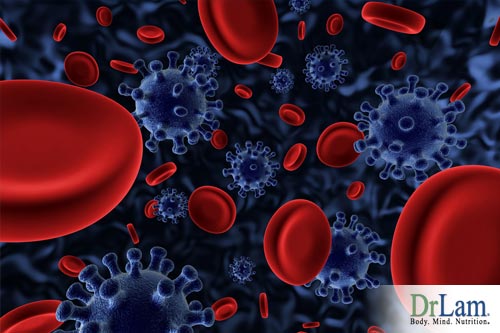
 Stealth viruses are pathogens that permeate the entire body. They are something that every one of us living in modern society has been exposed to. The curious thing about this is that even though we have all been exposed to a stealth virus, some of us fall very ill and suffer greatly while others seem to suffer no consequences and don’t feel ill at all.
Stealth viruses are pathogens that permeate the entire body. They are something that every one of us living in modern society has been exposed to. The curious thing about this is that even though we have all been exposed to a stealth virus, some of us fall very ill and suffer greatly while others seem to suffer no consequences and don’t feel ill at all.
Though “Stealth Virus” is the most common term for these types of infections, they are actually not limited to viruses – some are caused by bacterial, fungal and mycoplasma pathogens.
Examples of common stealth infections include:
The Epstein-Barr virus is one of the most prevalent in human beings. It is one of eight within the herpes family, and is usually transferred by the exchange of saliva and genital fluids.
Most of us infected with this virus gain immunity, but, for some, it can cause other health issues such as glandular fever and has been associated with certain types of autoimmune diseases and cancers.
Candida is a fungus, a type of yeast, that is the most common fungal infection affecting human beings. Though it is usually harmless in most cases, and actually exists in the gut flora naturally, there are some species that can cross mucosal barriers and cause infections. Also, the balance of the different species of gut flora can get out of whack, causing candida overgrowth.
Prolonged antibiotic use is one of the main ways that promotes the growth of candida because it causes an imbalance in the gut’s microbiota.
Though women are more susceptible to yeast infections, men can also become infected.
Lyme disease is a bacterial infection that comes from the bite of ticks that are carriers of the Borrelia-type bacteria. It often begins as a small area of redness at the site of the bite then begins to expand if not immediately treated. Some people then begin to develop a rash. Symptoms include tiredness, headaches and fevers.
If left untreated for long, symptoms worsen and can include a stiff neck, joint pain, loss of ability to move the sides of the face, heart palpitations and severe headaches.
These symptoms can repeat cyclically for years.
Other stealth pathogens include the different types of hepatitis viruses that cause hepatitis A, B, C and E; H. Pylori – which causes gastric pain and ulcers; and mycoplasmas – a common cause of walking pneumonia.
 Stealth viruses are named as such because at first, you may not feel so bad. But over time, they can take a toll on health and begin to affect you negatively in many ways. This may take five, ten or twenty years to develop, but at the end of the day, they do affect the body.
Stealth viruses are named as such because at first, you may not feel so bad. But over time, they can take a toll on health and begin to affect you negatively in many ways. This may take five, ten or twenty years to develop, but at the end of the day, they do affect the body.
The reason it could take so long is that these viruses are often undetected for years because they are so innocuous at first.
When you begin to feel tired and go to the doctors, the first thing they will check is your thyroid. And then they check your blood for anemia. It’s very rare that a doctor will check you for a stealth virus in this circumstance because stealth pathogens are often misunderstood and forgotten.
So the virus continues to live in your body and secrete toxins. And if your body is unable to withstand this naturally, your health deteriorates slowly and you are still at a loss as to what is really going on.
This is especially the case if you already suffer from Adrenal Fatigue Syndrome (AFS).
AFS is a set of symptoms that occur when the adrenal glands have become overworked and their hormonal output has become dysregulated. Symptoms include tiredness, brain fog, weight problems, insomnia, waking up in the middle of the night, heart palpitations, fertility issues and mood disturbances.
This can occur when you are exposed to chronic stress, mentally or physically, and your adrenal glands begin to increase their production of cortisol – the body’s main anti-stress hormone – to neutralize that stress. At later stages, the adrenals become exhausted and can no longer produce enough cortisol to handle the constant stress.
But the adrenal glands are not the only organs involved in the handling of stress. The body’s NeuroEndoMetabolic (NEM) Stress Response is actually composed of many different organs and circuits that coordinate together to fight stress. They are the cardionomic, neuro-affective, inflammatory, detoxification, metabolic and hormonal.
All of these systems can become dysregulated and negatively affected by chronic stress, causing a lot of problems with health and even day-to-day functioning. This is often compounded, or triggered, by the presence of other issues, such as viruses or infections, as well as an unhealthy lifestyle or exposure to toxins.
Stealth viruses and infections can actually cause stress and adrenal fatigue, and adrenal fatigue makes it even harder to fight off these pathogens. When your adrenal glands are not making enough cortisol to have the anti-inflammatory and suppressive responses, then, with time, these pathogens will take this opportunity to proliferate.
This situation is aggravated further if you suffer from adrenal crashes or are undergoing a very stressful situation in your life, physically or emotionally.
 Stealth viruses and infections behave in essentially the same way. They trigger an inflammatory response that is lower than usual but not fully suppressed. The inflammatory response stays on, what we can call, a “simmering” level. These viruses also release their toxins in a very slow and gradual way, which doesn’t bring forth strong reactions from the body at first.
Stealth viruses and infections behave in essentially the same way. They trigger an inflammatory response that is lower than usual but not fully suppressed. The inflammatory response stays on, what we can call, a “simmering” level. These viruses also release their toxins in a very slow and gradual way, which doesn’t bring forth strong reactions from the body at first.
This causes symptoms to be unclear and makes it very difficult to diagnose the root cause without extensive testing and investigation.
There are several other theories that touch upon why stealth viruses are so hard to detect, but the end result (the continuous low-grade inflammatory response) is the same.
Once discovered, trying to aggressively eradicate them from the body will actually make things worse. Using heavy courses of antibiotics may bring temporary relief from the acute symptoms and even reduce the toxic load for a while. But in the long run, this will backfire.
It is understandable, of course, that if you discover a stealth virus in your body you would want to do what it takes to get rid of it, but it is crucial to know that this approach may have an adverse effect on your health.
It’s also important to understand that we can never be rid of these pathogens completely – they are in the environment for better or for worse. So we will always be exposed to them. In fact, it is very possible to live with them in your body and still function properly and have a full life, provided that you are doing the right things to support your health.
On the other hand, if you overly treat these pathogens, expect there to be much collateral damage, especially in the gut. Your gastrointestinal (GI) tract will be affected, causing poor assimilation, gastric discomfort, pain, brain fog, diarrhea, fatigue and even anxiety.
For example, if you take an aggressive course of antibiotics to fight off a bacterial infection, you become more vulnerable to the overgrowth of candida. And with your GI tract compromised, your immune system is also compromised, making you more vulnerable to the invasion of stealth virus. For those who are in a weaker state, this could lead to what we call “detoxification and retoxification” reactions. This is why the approach we take to handle a stealth pathogen has to be a carefully considered one. Preparing your body is key, long before starting an eradication program.
First, the preparation needs to be nurturing and non-stimulating, and give the body enough time to be ready. The amount of time differs case by case - for some people it can be months, for others it can be even longer.
The long period of time is usually because by the time the virus is clinically bothersome enough to be discovered, it has already been years and your body is in a weak state.
 An example of how to approach this is, in the case of systemic candida, you need to have a very clean, sugar-free diet because yeast infections feed on sugar. With chronic Lyme disease, your body is already under a lot of stress – if you start to do excessive exercise or physical activities, your Lyme will flare up.
An example of how to approach this is, in the case of systemic candida, you need to have a very clean, sugar-free diet because yeast infections feed on sugar. With chronic Lyme disease, your body is already under a lot of stress – if you start to do excessive exercise or physical activities, your Lyme will flare up.
The moral of the story is to first make sure that you don’t have a stealth virus. And if you do, find a doctor who really understands how to have a comprehensive plan so you don’t overdo the treatment or do the wrong things, leading to a worsening of your state.
And if you suffer from adrenal fatigue, it is important to first recover from that and strengthen your adrenals before progressing to the treatment of the stealth virus itself.
In both cases, nutrition is the key to getting the body in a stronger, healthier state to deal with both AFS and the infection. Nutritional coaching for your particular condition and needs is a great way to do this.
